Top ten marine flora symbols: Phytoplankton, macroalgae, mangroves and seagrasses
Bill Dennison ·This is the first blog post in a series which celebrates the IAN symbol library by highlighting some of the most interesting symbols. There are currently 2660 symbols in the Integration and Application Network symbol library. This library has grown organically, with new symbols created by talented Science Communicators as they are needed. We have rarely stepped back and viewed this accruing library as a whole. This blog post initiates a series of top ten lists of various types of symbols to begin to reflect on the symbol library. My first reaction was to come up with a single top ten list, but it was quickly apparent that it would be too difficult to single out ten symbols across the diverse types of symbols. So I will begin this series with the origin of the IAN symbol library, in depictions of marine plants. The Marine Botany group at the University of Queensland was actively researching marine flora in Moreton Bay and on the Great Barrier Reef throughout the 1990s. Since the research focus was on the ecophysiology of various marine plants, the initial symbols created by the Marine Botany group were of these study organisms.
 1) The seagrass Zostera capricorni is the dominant seagrass species in Moreton Bay, Queensland. This seagrass species is very similar to one of the most studied seagrasses in the world, Zostera marina, which I studied for my Masters and PhD. In many ways, this seagrass represents my first love in marine botany and thus heads up my top ten list. The Science Communicator, Diane Kleine, who created this symbol was the first professional Science Communicator in the Marine Botany group.
1) The seagrass Zostera capricorni is the dominant seagrass species in Moreton Bay, Queensland. This seagrass species is very similar to one of the most studied seagrasses in the world, Zostera marina, which I studied for my Masters and PhD. In many ways, this seagrass represents my first love in marine botany and thus heads up my top ten list. The Science Communicator, Diane Kleine, who created this symbol was the first professional Science Communicator in the Marine Botany group.
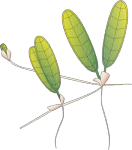 2) The seagrass Halophila decipiens is a small leafy species that grows in deep water. One of the most memorable research projects that I conducted was in the waters off St. Croix, US Virgin Islands. Susan Williams and I collaborated on a project comparing the daily growth patterns of this seagrass and her favorite research subject, a marine algae, Caulerpa taxifolia. We hypothesized that the highly evolved flowering plant with terrestrial origins (seagrass) would have different circadian growth rhythms than a more evolutionarily primitive marine algae. We used an underwater habitat, Hydrolab, to live at 60' below the water surface in Salt River Canyon so that we could manipulate the light/dark cycles of these marine plants and literally watch them grow, measuring them every 6 hours, day and night. Catherine Collier, a Marine Botany graduate student who is now a research faculty at James Cook University, created this symbol.
2) The seagrass Halophila decipiens is a small leafy species that grows in deep water. One of the most memorable research projects that I conducted was in the waters off St. Croix, US Virgin Islands. Susan Williams and I collaborated on a project comparing the daily growth patterns of this seagrass and her favorite research subject, a marine algae, Caulerpa taxifolia. We hypothesized that the highly evolved flowering plant with terrestrial origins (seagrass) would have different circadian growth rhythms than a more evolutionarily primitive marine algae. We used an underwater habitat, Hydrolab, to live at 60' below the water surface in Salt River Canyon so that we could manipulate the light/dark cycles of these marine plants and literally watch them grow, measuring them every 6 hours, day and night. Catherine Collier, a Marine Botany graduate student who is now a research faculty at James Cook University, created this symbol.
 3) The marine algae, Caulerpa taxifolia, is a most amazing organism. It is literally a giant single cell, with multiple nuclei that flow through the cytoplasm. The chloroplasts also flow throughout the cytoplasm and at night they go down into the belowground plant parts (called stolons) and during the day they rise up into the aboveground plant parts (called fronds). This symbol was created by Tracey Saxby, the Science Communicator who set up and maintains the IAN Symbol Library.
3) The marine algae, Caulerpa taxifolia, is a most amazing organism. It is literally a giant single cell, with multiple nuclei that flow through the cytoplasm. The chloroplasts also flow throughout the cytoplasm and at night they go down into the belowground plant parts (called stolons) and during the day they rise up into the aboveground plant parts (called fronds). This symbol was created by Tracey Saxby, the Science Communicator who set up and maintains the IAN Symbol Library.
 4) The freshwater aquatic plant Vallisneria americana (wild celery) is the most seagrass-like freshwater plant. It has long slender leaves and a fascinating reproduction strategy involving a female flower which stretches to the water surface for pollination and then is retracted down into the base of the plant. On family vacations to Upper Saranac Lake, we collected wild celery and analyzed the stable nitrogen isotope ratios to detect nutrient sources around the lake. Emily Benson joined IAN as a science communication intern and wrote up the results, published in Hydrobiologia 596(1): pp 187-196, before she started her graduate studies at the University of Alaska, Fairbanks. Tracey Saxby created this symbol.
4) The freshwater aquatic plant Vallisneria americana (wild celery) is the most seagrass-like freshwater plant. It has long slender leaves and a fascinating reproduction strategy involving a female flower which stretches to the water surface for pollination and then is retracted down into the base of the plant. On family vacations to Upper Saranac Lake, we collected wild celery and analyzed the stable nitrogen isotope ratios to detect nutrient sources around the lake. Emily Benson joined IAN as a science communication intern and wrote up the results, published in Hydrobiologia 596(1): pp 187-196, before she started her graduate studies at the University of Alaska, Fairbanks. Tracey Saxby created this symbol.
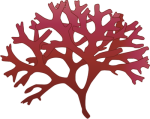 5) The red algae Chondrus crispus (Irish moss) is a distinctive brightly colored algae that grows on rocks of the North Atlantic Ocean. This symbol, drawn by Tracey Saxby, reminds me of the flashes of bright color amid a field of dull brown algae that I would see while diving off Cape Cod, Massachusetts during my PhD research. Irish moss is a rich source of carrageenan, a thickening agent used in food preparation.
5) The red algae Chondrus crispus (Irish moss) is a distinctive brightly colored algae that grows on rocks of the North Atlantic Ocean. This symbol, drawn by Tracey Saxby, reminds me of the flashes of bright color amid a field of dull brown algae that I would see while diving off Cape Cod, Massachusetts during my PhD research. Irish moss is a rich source of carrageenan, a thickening agent used in food preparation.
 6) The green algae Enteromorpha intestinalis is a bright green algae that is abundant around high nutrient sources. This symbol, drawn by Tracey Saxby, captures the growth form of paper-thin algal fronds that are folded and crinkled, and gas bubbles caught in the folded algal fronds which cause the algae to stretch upward toward the water surface.
6) The green algae Enteromorpha intestinalis is a bright green algae that is abundant around high nutrient sources. This symbol, drawn by Tracey Saxby, captures the growth form of paper-thin algal fronds that are folded and crinkled, and gas bubbles caught in the folded algal fronds which cause the algae to stretch upward toward the water surface.
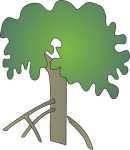 7) The mangrove Rhizophora stylosa (red mangrove) symbol, drawn by Diana Kleine, is one of the first symbols created in the symbol library. The red mangrove has one of the most distinctive growth forms of any coastal plant with its stilt roots. In doing a quick sketch of a coastal profile, the stilt roots of a red mangrove are instantly recognizable and totally unique.
7) The mangrove Rhizophora stylosa (red mangrove) symbol, drawn by Diana Kleine, is one of the first symbols created in the symbol library. The red mangrove has one of the most distinctive growth forms of any coastal plant with its stilt roots. In doing a quick sketch of a coastal profile, the stilt roots of a red mangrove are instantly recognizable and totally unique.
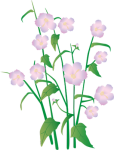 8) The salt marsh plant, Kosteletzkya virginica (seaside mallow), has beautiful soft purple flowers, and the symbol drawn by Tracey Saxby, captures its delicate beauty.
8) The salt marsh plant, Kosteletzkya virginica (seaside mallow), has beautiful soft purple flowers, and the symbol drawn by Tracey Saxby, captures its delicate beauty.
 9) The phytoplankton Prorocentrum minimum is a dinoflagellate which blooms to form 'mahogany tides' in Chesapeake Bay. It is quite difficult to distinguish many features in this microscopic organism even under a powerful microscope, so this symbol, drawn by Tracey Saxby, illustrates those salient features that can be distinguished microscopically, including the long flagella.
9) The phytoplankton Prorocentrum minimum is a dinoflagellate which blooms to form 'mahogany tides' in Chesapeake Bay. It is quite difficult to distinguish many features in this microscopic organism even under a powerful microscope, so this symbol, drawn by Tracey Saxby, illustrates those salient features that can be distinguished microscopically, including the long flagella.
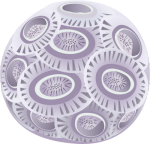 10) This type of phytoplankton produces distinct plates formed from calcium carbonate and is known as a coccolithophore. Blooms of coccolithophores can create 'whiting' events in which milky colored ocean waters cover vast stretches of the Atlantic Ocean, visible from space. This detailed symbol drawn by Tracey Saxby is amazingly realistic and captures the symmetrical beauty of this microscopic organism.
10) This type of phytoplankton produces distinct plates formed from calcium carbonate and is known as a coccolithophore. Blooms of coccolithophores can create 'whiting' events in which milky colored ocean waters cover vast stretches of the Atlantic Ocean, visible from space. This detailed symbol drawn by Tracey Saxby is amazingly realistic and captures the symmetrical beauty of this microscopic organism.
About the author
Bill Dennison

Dr. Bill Dennison is a Professor of Marine Science and Vice President for Science Application at the University of Maryland Center for Environmental Science.

